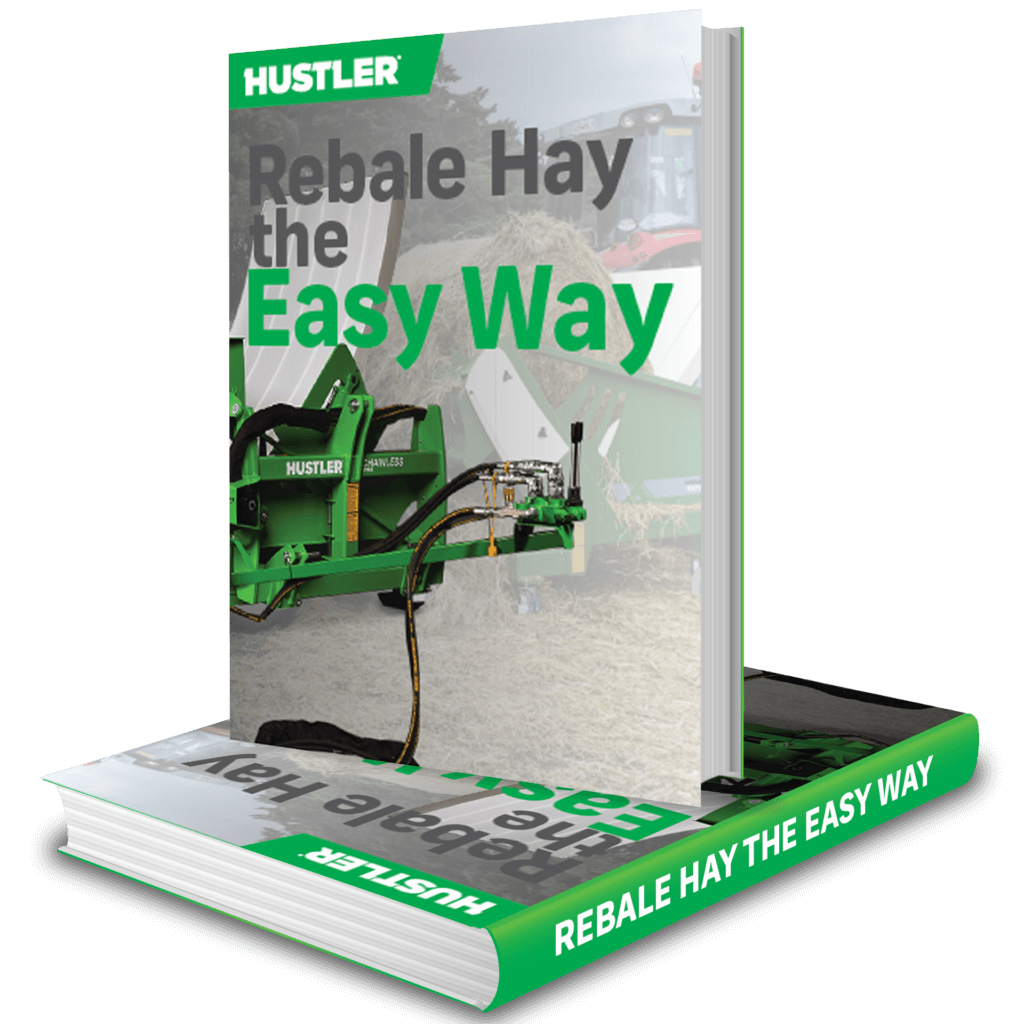Rebaling hay is a process of taking large round bales or large square bales of hay and reprocessing them to create smaller square bales. This is mainly done to cater to the needs of customers who prefer small square bales for their livestock (horse studs, hobby farms, contractors, landscapers, etc).
This process sometimes also involves sorting and removing any unwanted material, such as weeds or foreign objects, that may have been included in the original bales.
Rebaling hay is a fairly easy process that mainly involves using an indoor or outdoor stationary system (permanent or temporary), which requires:
- A bale converter or bale feeder that unrolls or separates round and big square bales, such as the Hustler Chainless LX105 or the Hustler Unrolla LX105 (for round bales only) that fluffs up the hay or straw and feeds it into the pickup of a small square baler.
- A small square bale baler that is fed by the bale converter or bale feeder.
- A tractor or an independent unit that powers the machines.
- An optional bale accumulator that can be used to package the bales into bundles of 18 or 21 bales for shipping or storage in enclosed semi-trailers as they leave the bale chute.
And voilà!
Converting large round bales into small conventional square bales can be beneficial for several reasons:
-
Increased Marketability and Profit
In some areas, it is easier to sell smaller square bales compared to large round bales, as they can be more desirable for certain uses, such as for horse feed or for small hobby farms. Selling small square bales is more attractive than selling large bales when the price is considered on a per-ton or per-pound basis.
-
More flexibility
The weather can be fickle and sometimes the opportunities for making hay are very limited. It is usually much faster to bale large round bales of hay than small square bales for two main reasons:
– depending on the type of hay and the terrain, it is generally faster to bale round bales (average speed 8-10 mph) than small square bales (average speed 3-5 mph)
– picking up small square bales often involves labor to pick up or a bale collector which is slower than a claw
What’s more, you can choose to convert your bales whenever you want, whether it’s winter or summer or when there’s less activity on the farm.
- Less Labor Involved
If one person can handle cutting, tedding, and baling the hay into small or large bales, the task of picking up small bales can still be labor-intensive. Unlike large bales, collecting small bales often requires more time and effort. While a bale accumulator can make the process easier, it’s an expensive piece of equipment and still slower than collecting large bales. Fortunately, converting the hay can be done by one person easily, especially with the Hustler bale feeder, which can be controlled from a convenient distance with the Ez Remote folding arm.
Hustler Equipment’s Rebalers are designed to make the process of converting large round bales into small square bales more efficient and cost-effective. Contact us for more information!
Let’s do the math: a large round bale of hay can cost as little as $30, but it can be turned into 21-22 small square bales, worth an average of $3-4 each, sometimes much more for good quality organic hay!
These small bales can be sold for as much as $63-88, which is at least $33 more, more than double the original value!
Hustler Equipment’s Rebalers are the perfect machine to break down your large bales on a conveyor belt or even directly in the pickup of your small square baler. The variable low-speed hydraulic drives gently pull apart large round or large square bales, turning them into 21-22 small squares in just a few minutes.
So yes, you can turn your hay into cash with Hustler Equipment’s Rebalers! Unlock the hidden potential of your hay today and consider the benefits of rebaling. Contact us for more information.
According to research conducted by the Swedish University of Agricultural Sciences in 2020*, rebaling can be done without causing significant changes in the chemical composition of the forage. This means that the quality of the hay is largely preserved during the process. However, as with all hay handling, it is important to take precautions to prevent moisture from entering the hay or the bale before or after the process. Moisture can lead to high yeast and mold counts.
Choosing the right bale converter or feeder is crucial. While some processes, such as using a flail-type bale processor or straw blower, can damage the forage by removing leaves from the stems, this won’t happen with Hustler Equipment’s Rebalers. Our machines are designed to gently fluff up the hay and make the process of converting large round bales into small square bales more efficient and cost-effective. Contact us for more information!
*Müller CE, Johansen A. Rebaling of silage and haylage and its effects on forage microbial and chemical composition—A pilot study. Grass Forage Sci. 2020;75:216–226
Glad you’re asking! Are you unsure whether rebaling your hay is worth the time and effort? It depends on your market demand. If there is little or no market for small square bales in your area, you may be better off baling a few acres directly in small squares. However, if demand is high and fluctuates throughout the year, rebaling on-demand can result in a significant boost in income when prices are favorable.
Rebaling hay also offers convenience, as you can do it during downtime on the farm, at your own pace, without worrying about the weather.
Unlock the hidden potential of your hay today and consider the benefits of rebaling. Contact us for more information!

